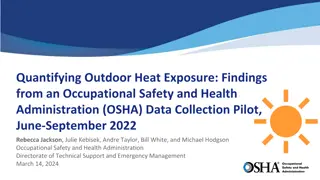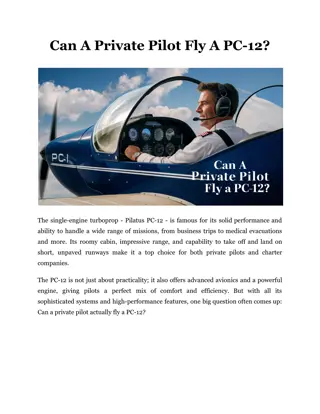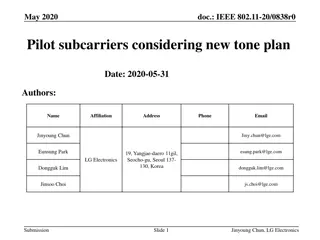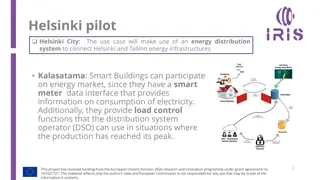Power-On Stalls in Private Pilot Training
Explore the fundamentals of power-on stalls in aviation training, including aerodynamics, stall speeds, recovery techniques, and the importance of mastering these maneuvers to enhance flight safety. Learn why stalls occur, how to recognize them, and the science behind aerodynamic stalls. Gain insights into factors influencing stall speed, critical angles of attack, and airflow over the wing. Prepare for entering, recognizing, and recovering from power-on stalls effectively.
Uploaded on Sep 20, 2024 | 0 Views
Download Presentation

Please find below an Image/Link to download the presentation.
The content on the website is provided AS IS for your information and personal use only. It may not be sold, licensed, or shared on other websites without obtaining consent from the author.If you encounter any issues during the download, it is possible that the publisher has removed the file from their server.
You are allowed to download the files provided on this website for personal or commercial use, subject to the condition that they are used lawfully. All files are the property of their respective owners.
The content on the website is provided AS IS for your information and personal use only. It may not be sold, licensed, or shared on other websites without obtaining consent from the author.
E N D
Presentation Transcript
Power On Stalls Private Pilot Curriculum Stephen Saslow August 2020
Objective The student should develop knowledge of stalls regarding aerodynamics, factors associated with stall speeds, as well as proper recovery techniques. The student will understand situations in which power on stalls are most common and most dangerous and will have the ability to perform a power- on stall as required in the ACS/PTS.
Elements of Power On Stalls 1. Aerodynamics 2. Various Factors and their Effect on Stall Speed 3. Possible Situations for a Power-On Stall 4. Entering the Maneuver 5. Recognizing the Stall 6. The Recovery
What are Stalls, Why Do We Learn Them? A stall occurs when the critical angle of attack is exceeded. When this happens, the smooth airflow over the wing is disrupted resulting in a loss of lift and increased drag. Power on stalls (also known as departure stalls) are practiced to simulate stalls in the takeoff and climb-out conditions and configuration. Stalls in general are practiced to become familiar with an aircraft s particular stall characteristics and to avoid putting the aircraft into a potentially dangerous situation. Power- on stalls are essential to safety in the aircraft. It is important to understand how they happen, how to avoid them, and how to recover from them.
Why an Aircraft Stalls A stall occurs when the smooth airflow over the top of the wing is disrupted and lift decreases rapidly This happens when the wing exceeds its critical angle of attack (AOA) The critical AOA varies between aircraft, but is usually around 15-20 degrees in a general aviation aircraft Remember, AOA is the angle between the chord line of the wing and the relative wind A stall can occur at any airspeed, in any attitude, with any power setting How To Perform a Stall
The Science Behind Stalls What makes an airplane stall? Airflow Over the Wing A certain amount of lift is generated by the difference in pressure between the top and bottom of the wing. This lift is dependent on the smooth airflow over the top of the wing (A in the graphic below) As AOA increases, the airflow over the top of the wing cannot maintain the smooth flow and starts to burble and separate from the trailing edge (B in the graphic below) As the AOA continues to increase, the separation point moves farther forward along the top of the wing hindering its ability to create lift, and leading to airflow separation and a stall (C in the graphic below) Thus, a stall occurs due to a rapid decrease in lift caused by the separation of the airflow from the wing s surface
The Science Behind Stalls The Critical Angle of Attack The point at which the airflow separates and there is a rapid reduction in lift is the stalling angle of attack, or the critical angle of attack, or CLMAX (the Maximum Coefficient of Lift) see the diagram below CL = Coefficient of Lift A way to measure lift as it relates to the angle of attack Determined by wind tunnel tests and based on airfoil design and angle of attack Any angle of attack beyond CLMAX results in a stall and lift drops off rapidly
The Science Behind Stalls Stall Characteristics Most general aviation aircraft are designed to stall at the wing root first and then progress outward to the wing tips By having the root stall first, aileron effectiveness is maintained at the wingtips, maintaining controllability of the aircraft Various design can be used to accomplish this: Twisting the wing to create a lower angle of attack at the wing tip compared to the wing root Angle of Incidence The angle of the chord line of the wing relative to the fuselage These aircraft are designed with a higher angle of incidence near the wing root, leading to a lower angle of incidence at the wing tip Adding strips to the first 20-25% of the wing s leading edge to induce a stall earlier than it would otherwise stall
The Science Behind Stalls An aircraft can stall at any speed, attitude, or power setting Low Speed As airspeed decreases, the AOA must be increased to maintain altitude Eventually, an AOA is reached that results in the wing not producing enough lift to support the aircraft. If the airspeed is reduced further, the aircraft stalls because the AOA has exceeded the critical angle and the airflow over the wing is disrupted High Speed Low speed is not necessary to produce a stall, the wing can exceed the critical AOA at any speed. For example: If an aircraft is in a high speed dive, and the pilot pulls back sharply on the elevator, gravity and centrifugal force prevent an immediate alteration of the flight path In this situation, the aircraft s AOA changes abruptly from quite low to very high, but even though the nose has been raised, the aircraft continues on its trajectory downward for some amount of time Since the AOA is suddenly increased while the flight path remains the same, the aircraft reaches the critical AOA at a speed much higher than the published stall speed
The Science Behind Stalls An aircraft can stall at any speed, attitude, or power setting Turns The stall speed of an aircraft is higher in a turn than in straight-and-level flight In a turn, the wings must produce additional lift to maintain altitude Remember, in a turn the vertical component of lift is divided into a horizontal and a vertical component The additional lift comes from added back pressure which increases the AOA In this situation, the flight path/relative wind remain the same, while the pitch is increased, leading to a higher AOA If at any time during the turn the AOA becomes excessive, the aircraft will stall
The Science Behind Stalls Various Factors and their Effect on Stall Speed A stall can occur at any airspeed, attitude, or power setting, depending on the total factors affecting the aircraft Airspeed & Power Settings (Not part of the CFI PTS Private and Commercial ACS Requirement) As mentioned above, a stall can occur at any airspeed Low Speed and/or Low Power Setting As airspeed decreases, AOA must be increased to maintain altitude Eventually, an AOA is reached that results in the wing stalling because the AOA has exceeded the critical angle and the airflow over the wing is disrupted High Speed and/or High Power Setting If an aircraft is in a high speed dive, and the pilot pulls back sharply on the elevator, gravity and centrifugal force prevent an immediate alteration of the flight path Since the AOA is suddenly increased while the flight path remains the same, the aircraft reaches the critical AOA at a speed much higher than the published stall speed More on load factors/accelerated stalls below Depending on the aircraft, a higher power setting may help to reduce the stall speed and increase the lift on the wings Although the wing may be stalled, a higher power setting can provide increased lift due to the propeller airflow/prop wash moving over the wing roots This is more prominent in low wing aircraft where the propeller airflow moves directly over the wing This airflow also likely has a relatively low angle of attack
The Science Behind Stalls Various Factors and their Effect on Stall Speed (continued) Configuration (Gear and Flaps) Flaps Reduce the stall speed of an aircraft Most flaps increase the camber of the wing and change the chord line, producing more lift The nose of the aircraft is lowered to prevent ballooning Generally, the lowered nose and additional lift assist in decreasing the stall speed (factors will vary based on aircraft/flap design) Note the differing speeds on the airspeed indicator (green arc vs white arc) Gear Flaps have the most prominent effect on stall speed The effects of gear can vary based on the aircraft design and characteristics Gear (as well as flap) extension increases drag and if not properly compensated for could lead to a stall For example, gear down and a low power setting, combined with increasing pitch to maintain altitude The actual effect of landing gear on the stall speed will vary between aircraft and their design characteristics
The Science Behind Stalls Various Factors and their Effect on Stall Speed (continued) Weight As the weight of the aircraft is increased, the stall speed increases Remember, to maintain altitude lift must equal weight So, the greater the weight, the greater the lift required A higher AOA is required to generate the lift (all other factors remaining the same) The higher AOA puts the aircraft closer to the critical angle of attack, and therefore the aircraft will stall at a higher speed A lighter aircraft will stall at a slower airspeed The same as above, but the opposite. Less lift is required, and the AOA can be reduced (all other factors remaining the same), lowering the stall speed
The Science Behind Stalls Various Factors and their Effect on Stall Speed (continued) Center of Gravity (CG) Forward Center of Gravity (CG) Increases the stall speed A forward center of gravity has the same effect on stall speed as a heavier aircraft The farther forward the center of gravity moves, the higher the angle of attack has to be to compensate for the extra load imposed by the tail (see picture) Due to the higher angle of attack, the aircraft is closer to the critical angle of attack and therefore will stall at a higher speed The aircraft is also more controllable due to the longer arm from the CG to the elevator, improving the stall recovery capabilities Additionally, the farther forward the CG, the greater the tendency for the nose to pitch down (imagine it as more nose heavy ) It s worth noting: The higher angle of attack and increased deflection of the stabilizer increases drag, and thus the aircraft is slower for a given power setting
The Science Behind Stalls Various Factors and their Effect on Stall Speed (continued) Center of Gravity (CG) Aft Center of Gravity CG Decreases the stall speed An aft center of gravity has the same effect on stall speed as a lighter aircraft The farther aft the center of gravity moves, the lower the angle of attack has to be to compensate for the load imposed by the tail Due to the lower angle of attack, the aircraft is farther from the critical angle of attack and will stall at a lower speed Although the stall speed is lower, the aircraft is less controllable due to the shorter arm from the CG to the elevator The elevator has a shorter arm to the CG, and thus produces less force making recovery more difficult Recovery from a stall becomes progressively more difficult as the CG moves aft Additionally, the farther aft the CG, the less tendency the nose has to pitch down on its own (imagine it as more tail heavy ) It s worth noting the lower angle of attack and less downward deflection of the stabilizer reduces drag, and thus the aircraft is faster for a given power setting
Load Factor Increased load factor increases the stall speed Load factor is the ratio of the total load acting on the aircraft to the gross weight of the aircraft Expressed in terms of G s Any increase in the load factor increases the stall speed The stall speed increases in proportion to the square root of the load factor When an aircraft is stalled at a higher than indicated air speed due to excessive maneuvering loads, it is called an accelerated maneuver stall Pulling out of a steep descent, steep turns, aggressive control inputs, etc. Anything that puts G s on the aircraft can increase the load factor and therefore the stall speed The Science Behind Stalls
Bank Angle Increased bank angle increases the stall speed Increased load factors are a characteristic of all banked turns Tremendous loads are imposed on an airplane as the bank is increased beyond 45o At a 60 degrees bank, a load factor of 2 G s is imposed on the airplane structure At a 70 degrees bank, a load factor of approximately 3 G s is placed on the airplane At approx. 63 degrees of bank the stall speed is increased by approximately The Science Behind Stalls
Snow, Ice, and Frost Increase the stall speed Snow, ice and frost disrupt the smooth flow of air over the wing causing the boundary layer to separate at an angle of attack lower than the critical angle of attack To make matters worse, lift is greatly reduced due to the disrupted air, and if ice accumulates, the weight of the aircraft is increased More lift is required due to the added weight, but less lift is available due to the ice As little as .8 millimeters of ice on the upper wing increases drag and reduces lift by 25% The Science Behind Stalls Turbulence Can increase the stall speed Sudden changes in the relative wind, and/or aggressive control inputs to maintain altitude can lead to exceeding the critical angle of attack and a stall When flying in moderate to severe turbulence or strong crosswinds, a higher than normal approach speed should be used
Stalls and the Senses Hearing Visually Feel Stall warning horn Loss of RPM This is due to increased load on the propeller Noise will tend to decrease with airspeed and the slower flow of air around the aircraft Nose high attitude of the airplane Particularly in a power-on stall Control pressures become progressively less effective (mushy) The lag between control movements and response of the aircraft become greater Buffeting, uncontrollable pitching or vibrations just before the stall The buffet is caused by the turbulent air flowing from the wings, over the fuselage and to the horizontal stabilizer Leaning back
Performing Power-On Stalls Objective: Demonstrate recognition of and recovery from a power on stall. Purpose: To become familiar with an aircraft s particular stall characteristics and to avoid putting the aircraft into a potentially dangerous situation. Understand how they happen, how to avoid them, and how to recover from them. Commercial Pilot ACS Skills Standards 1. Clear the area. 2. Select an entry altitude that will allow the Task to be completed no lower than 1,500 feet AGL (ASEL) or 3,000 feet AGL (AMEL). 3. Establish the takeoff, departure, or cruise configuration, as specified by the evaluator, and maintain coordinated flight throughout the maneuver. 4. Set power (as assigned by the evaluator) to no less than 65 percent available power. 5. Transition smoothly from the takeoff, departure, or cruise attitude to the pitch attitude that will induce a stall. 6. Maintain a specified heading, 10 if in straight flight; maintain a specified angle of bank not to exceed 20 , 10 , if in turning flight, until an impending stall or full stall is reached, as specified by the evaluator. 7. Acknowledge the cues at the first indication of a stall (e.g., aircraft buffet, stall horn, etc.). 8. Recover at the first indication of a stall or after a full stall has occurred, as specified by the evaluator. 9. Configure the airplane as recommended by the manufacturer and accelerate to VX or VY. 10. Return to the altitude, heading, and airspeed specified by the evaluator. Private Pilot ACS Skills Standards 1. Clear the area. 2. Select an entry altitude that will allow the Task to be completed no lower than 1,500 feet AGL (ASEL) or 3,000 feet AGL (AMEL). 3. Establish the takeoff, departure, or cruise configuration, as specified by the evaluator, and maintain coordinated flight throughout the maneuver. 4. Set power (as assigned by the evaluator) to no less than 65 percent available power. 5. Transition smoothly from the takeoff, departure, or cruise attitude to the pitch attitude that will induce a stall. 6. Maintain a specified heading, 10 if in straight flight; maintain a specified angle of bank not to exceed 20 , 10 , if in turning flight, while inducing the stall. 7. Acknowledge the cues of the impending stall and then recover promptly after a full stall occurs. 8. Execute a stall recovery in accordance with procedures set forth in the POH/AFM. 9. Configure the aircraft as recommended by the manufacturer and accelerate to VX or VY. 10. Return to the altitude, heading, and airspeed specified by the evaluator.
Overview Select outside visual references, such as a cloud Use both instrument indications and visual references Frequently reference the instruments, but do not fixate on them Stay coordinated! Performing Power-on Stalls
Performing Power-on Stalls The Maneuver Properly clear the area Pre-Maneuver Checklist: ex. Fuel Pump ON, Mixture RICH, Lights ON, Gauges GREEN Select an altitude - Must be able to recover prior to 1,500 AGL Takeoff Configuration: Takeoff Flaps as appropriate for your airplane Note the Heading (bug the heading) Common Error - Failure to establish the specified landing gear and flap configuration prior to entry
Execution Entering the Straight-Ahead Power-on Stall Reduce power to slow to normal lift off speed (VR - 55 kts) while maintaining altitude Visually - The nose will pitch above the horizon, use a cloud, or other visual reference to maintain direction At VR, increase power to 2200 RPM and maintain a climb attitude (12-15 degrees) until the stall occurs The nose will have a tendency to continue to pitch up and yaw to the left Establish and maintain the desired pitch attitude As airspeed decreases, and controls become less effective, continue increasing back pressure in order to maintain the pitch attitude With the wings level, maintain heading with the necessary right rudder, keeping the aircraft coordinated Apply right rudder when applying power to counter the left turning tendencies Common Error - Improper torque correction As airspeed decreases, and the rudder becomes less effective, increase right rudder pressure to maintain coordination Visual references should be primary during the maneuver, but back them up with the instruments Common Error - Improper pitch, heading, yaw, and bank control during straight ahead and turning stalls Common Error - Rough and/or uncoordinated control procedure Just like in slow flight, use smooth movements to control the aircraft, nothing jerky Larger control inputs will be necessary as the aircraft slows as the controls become less effective Performing Power-on Stalls
Performing Power-on Stalls Execution Entering the Turning Power-on Stall In a climbing turn, the same procedures apply as a straight-ahead stall, except a specified bank angle is maintained (the Airplane Flying Handbook mentions 15-20o of bank) When power is applied and the aircraft is pitched up for the climb, establish the desired bank angle Aileron pressure must be continually adjusted to keep the bank constant Opposite aileron will likely be necessary to maintain the bank angle, if left alone, bank will increase on its own due to the overbanking tendency Overbanking Tendency: The slower the airspeed, the smaller the turn radius As airspeed continually slows in a turning stall, the radius of the turn continues to decrease The smaller the radius of the turn, the greater the difference in distance traveled between the outer and inner wing Because the outer wing is traveling a further distance in the same amount of time (it s going faster than the inner wing), it is generating more lift. This leads to the overbanking tendency Opposite aileron is required to counter the overbanking tendency Maintain coordination throughout the maneuver This is especially important in a turning, power on stall due to the increased chance of a spin Common Error - Improper pitch, yaw, and bank control during turning stalls Anticipate the overbanking tendency Increase control pressure as the aircraft slows and controls become less effective
Execution Recognizing the Stall Announce the onset of the stall Stall Warning Horn Reduced Control Effectiveness Buffet Stall Sight Nose high attitude of the airplane Especially high in a power on stall Sound Stall warning horn Loss of RPM is noticeable due to the increased load on the propeller Noise will tend to decrease with airspeed and the slower flow of air around the aircraft Kinesthesia (the sensing of movements by feel, seat of the pants sensations, your spidey sense ) The physical sensation of changes in direction is an important indicator to the trained and experienced pilot in visual flight If properly developed, it can warn the pilot of an impending stall The pilot can recognize when something doesn t feel right Feel Control pressures become progressively less effective (mushy) The lag between control movements and response of the aircraft become greater Buffeting, uncontrollable pitching or vibrations just before the stall The buffet is caused by the turbulent air flowing from the wings, over the fuselage and to the horizontal stabilizer Common Error - Failure to recognize the first indications of a stall Common Error - Poor stall recognition and delayed recovery Common Error - Failure to achieve a stall Ensure a stall has developed. Indications that the aircraft has reached a stall will vary between aircraft Performing Power-on Stalls
Performing Power-on Stalls Execution The 3 Step Recovery Process First, the pitch attitude and angle of attack must be decreased positively and immediately Since the cause of any stall is an excessive angle of attack, decreasing the angle of attack is crucial for stall recovery Be familiar with the control pressures required for your aircraft. The amount of forward pressure required will vary based on aircraft Excessive pitch down can result in excessive altitude loss Insufficient pitch down will not break the stall If the nose is trimmed up, additional pressure will be required to break the stall If able, trim the nose down during the recovery
Execution The 3 Step Recovery Process Second, maximum allowable power should be applied to increase airspeed and help increase airflow over the wings, assisting in stall recovery Power is not essential to stall recovery, reducing the AOA is the only way of recovering Right rudder will be required to maintain coordination/heading Outside references are very helpful in maintaining coordination - as power is introduced add rudder pressure in order to keep the nose from yawing across the horizon Performing Power-on Stalls
Performing Power-on Stalls Execution The 3 Step Recovery Process Third, regain/maintain directional control with coordinated use of aileron and rudder and climb out at VY (or VX if necessary)
Performing Power- on Stalls Execution The 3 Step Recovery Process Common Error Poor stall recognition and delayed recovery Understand the signs of a stall and recover immediately Common Error - Excessive altitude loss or excessive airspeed during recovery Only lower the nose enough to break the stall, after the stall is broken establish a climb Excessive speeds and nose low attitudes close to the ground are extremely hazardous Common Error - Secondary stall during recovery Once the stall is broken, do not aggressively lift the nose to reestablish a climb as this can quickly result in a secondary stall Use smooth, controlled inputs and monitor the performance to ensure it is ready to climb
Execution Ailerons and Recovery Most general aviation aircraft are designed to stall progressively outward from the wing root The wings are designed in this manner so that aileron control will be available at high AOA and give the airplane more stable stalling characteristics During the recovery, the return of lift begins at the tips and progresses towards the roots Thus, ailerons can be used to level the wings If the wing is fully stalled (ailerons included), using the ailerons can result in an aggravated stall condition EX: If the right wing dropped, and excessive aileron was applied to raise the wing, the right wing (aileron down) would produce a greater AOA and more (induced) drag Increasing the AOA on an already stalled wing will aggravate the stall on that wing The increase in drag and aggravated stall on the low wing will yaw the aircraft in the direction of that wing and could result in a spin Performing Power-on Stalls
Execution Rudder and Recovery The primary cause of an inadvertent spin is exceeding the critical AOA while applying excessive or insufficient rudder and, to a lesser extent, aileron. Therefore, it is important that the rudder be used properly during the entry and recovery The primary use of rudder is to counteract any tendency of the airplane to yaw or slip One wing will often drop in a power-on stall Maintaining directional control and coordinated flight with the rudder is vital in avoiding a spin Performing Power-on Stalls
Failure to establish the specified landing gear and flap configuration prior to entry Improper pitch, heading, yaw, and bank control during straight ahead and turning stalls Improper pitch, yaw, and bank control during turning stalls Rough and/or uncoordinated use of flight controls Failure to recognize the first indications of a stall Failure to achieve a stall Improper torque correction Poor stall recognition and delayed recovery Excessive altitude loss or excessive airspeed during recovery Secondary stall during recovery Common Common Errors Errors
Power-on Stalls: Conclusion Exceeding the critical angle of attack causes a stall. A stall can occur at any airspeed, in any attitude, or at any power setting, depending on the total number of factors affecting the particular airplane.























